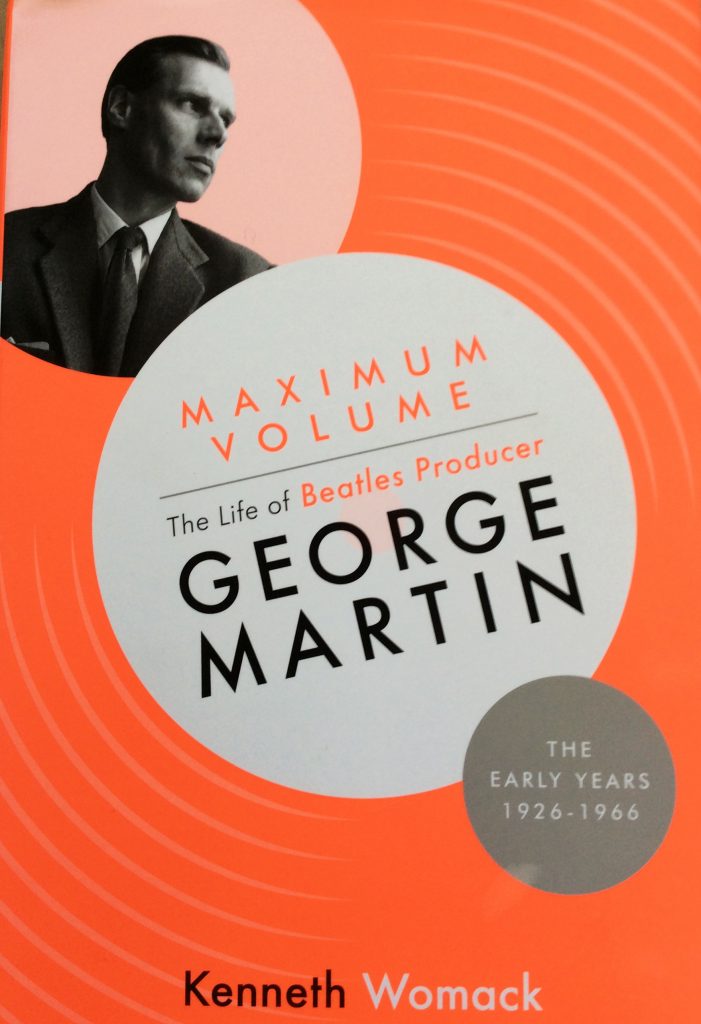George Martin is an enigmatic figure for Beatles fans. Our favourite group’s meteoric rise to the heights of popularity and creativity is well documented, and everyone knows about George Martin’s role as a producer of Beatles records. But do we really know what kind of person was he? Where did he come from and what qualities did he possess to be the force behind putting the Beatles’ creative talent on record? With those questions in mind, I started on Maximum Volume: The Life of Beatles Producer George Martin, the Early Years, 1926-1966 by Kenneth Womack.
To some extent, the book does give an insight into George’s life, particularly before his occupation as a Beatles producer. Despite his posh accent and demeanour in later life, George’s parents struggled to make a decent living during the depression of the 1930s, and the life of his family during his young years was far from well off, or even comfortable. George was a capable and conscientious learner, and his firm footing in independent life started with training and later serving in the Royal Navy’s Fleet Air Arm during the latter part of the Second World War and the after war years.
I was curious to learn that George had a perfect pitch, and played the piano a lot, mostly by ear, without much formal training. This held him back, in terms of a career in music, until he did a course in piano and oboe at the Guildhall School of Music and Drama.
It is also interesting to note that George did not contemplate a career in music production, but it so happened that shortly after graduating from Guildhall, he received an offer of a job as an assistant at EMI’s Parlophone Records, later progressing to be its head. George developed a solid reputation as a producer of novelty and comic records, working with the such leading entertainers as Peter Sellers and Spike Milligan.
Defining the role of a record producer, as we know it today, was not an easy road for George. Looking up to successful producers of the day, George had been aspiring to find a pop hit group for a good while, until he met the Beatles – and the rest is history.
Up to this moment in the book I found it really fascinating, as I did not know much about George’s life until then. His early years’ struggles, his first love and marriage, his ambitious aspirations and dreams – this brings the mysterious figure of George Martin closer to me. I am, however, cautious to trust the author’s descriptions of George’s feelings, which seem to be particularly numerous in the beginning of the book, – this is an autobiography, and can you really put other people’s feelings on paper accurately, if you are not the person experiencing them yourself, even if you studied all the primary sources? It does bring the story to life, but does it gives an accurate picture? Only George could tell that, and he is no longer with us…
The Beatle years of George’s life have been so well documented that any self respecting Beatles fan would have no trouble finding out how many takes of She Loves You were made, what day of the week the recording session of I Want To Hold Your Hand was, or what instruments were used on a particular take of In My Life.
Kenneth Womack does give us a detailed account of George’s contribution to the Beatles’ creative process, and some glimpses into George’s life outside the Beatles at this time. However, for me, this does not build as much of a picture of George during those years as in his early life. George comes through as a man of high principles and great honesty, both in his dealings with his artists, as well as with his employers at EMI, who failed to properly recognise his contribution to Parlophone’s success and never recompensed him fairly. Whether George’s working relationship was based on mutual trust and respect, as in the case of Brian and the Beatles, or had a few clashes along the way, like with Dick Lester, his creativity and a firm grasp on always came through.
The book leads us – rather quickly, I thought – through the array of other artists that George worked with, as well as his composing and arranging achievements.
The book ends with the story of how George’s own company AIR came about, and his hopes and aspirations for it going into the future in 1966. All we need now is the second volume to complete the picture.


